
Dietary fats and its attention in the media (especial social) world have gone to two extremes, causing a conundrum for how personal trainers should counsel their clients. First, dietary fats have been vilified for causing weight gain, heart disease, and several other issues. On the flip side, eating a high amount of fat (70-80%) of one’s diet is celebrated as being a magic approach to lose weight (keto). Neither are absolutely true, certainly not for every person. Research in the area of nutrition continues to evolve; these insights indicate that consumption of healthy fats is key to a balanced diet. That said, we want to always be mindful of how much dietary fat (and the types of fat) our clients consume.
Despite what the current body of research says, there’s still a misconception that consuming fat will result in weight gain and increased body fat. When clients come to you for nutritional insight and guidance, it’s important that you be able to confidently answer questions and provide educational tools that allow clients to integrate beneficial fats into their daily dietary habits.
Types of Fats
There are three overarching categories for dietary fat: saturated, polyunsaturated, and monounsaturated. There are also Trans fats, which can be both naturally occurring and man-made. All fats contain 9 calories/gram (more than twice the caloric density of carbs and protein). Let’s look at the differences between these dietary fats.
Saturated fats are typically solid at room temperature and can be found in animal-based foods (beef, poultry, full-fat dairy, eggs, tropical oils). Consuming a diet too high in saturated fats can become problematic as this is associated with higher cholesterol levels. The American Heart Association recommends consuming 5-6% of calories from saturated fat.
Polyunsaturated fats have beneficial effects on the cardiovascular system (when eaten in moderation). These dietary fats are have more than one unsaturated carbon bond, and are liquid at room temperature. Oils such as soybean, corn, and sunflower are all high in this type of fat. Other sources include walnuts and flaxseeds.
Monounsaturated fats are also beneficial for the heart. Chemically, these fats contain one unsaturated carbon bond and are also liquid at room temperature. Examples of oils that contain this type of fat include olive, canola, peanut, safflower, and sesame oil. Other sources include avocados, peanut butter, and different nuts/seeds.
Artificial trans fats are the worst type of fat to consume. Research suggests that reducing these man-made fats can reduce the risk of heart disease. While some trans fats are naturally occurring (as they are produced in the gut of animals), some milk and meat products can contain trace amounts. However, processed foods include trans fats that are manufactured and added to that product – primarily because it’s cheap and gives food flavor and a longer shelf-life. That said, in 2013, the U.S. FDA made the determination that trans fats (partially hydrogenated oils) are no longer “GRAS” (generally recognized as safe).
Trans fats raise the bad (LDL) cholesterol and lower the good (HDL) cholesterol. Eating trans fats is also associated with a higher risk of Type 2 diabetes. It’s this type of fat, along with saturated fats, that we want to encourage clients to limit due to the disease risk associated with both.
Some Quick Fat Facts to Share with Clients
• Dietary fat is not the same thing as body fat
• Not all fats are created equal
• Fats provide structural building blocks of the body (the brain is 60-70% fat!)
• Cholesterol plays a role in hormone development
• Fats are necessary for growth and development
• Fats are a usable energy source for the body
• Different types of fats have different effects on the body
Eating fats will not result in making you or your clients fat. That said, as with anything, it’s important to focus on the bigger balanced picture – a healthy eating style that matches the needs of each client.
Focus on the Relevant Information
To educate clients (or any audience), present the information in such a way that it is salient and relevant. Clients want to know why the information is important and how they can apply it and integrate it into their daily lives.
Some tools you can use to help you convey the message and application of information include cooking demos, grocery shopping tours, food journals, recipes, research studies and/or position statements. Consider client personality and determine what tools might be the most effective.
Educating about Dietary Fats
While it isn’t within your certified scope of practice to offer nutrition counseling, medical nutrition therapy, or provide specific and individualized nutrition plans to clients, it is within your licensed responsibilities to discuss why dietary fat is important and how they benefit the body and fuel performance. Some topics you might consider include:
• Differences in the types of fats (saturated, unsaturated, trans fats)
• The role fats play within the body
• Food sources of the various types of fats
• Evaluating food labels for fat content and cholesterol
• The difference between Omega-3 and Omega-6 fatty acids (and how to balance the anti-inflammatory and pro-inflammatory sources)
• Selecting quality oils for cooking and baking
How Much Dietary Fat?
If we understand anything about nutritional dynamics, it’s that there’s no one-size-fits-most approach when it comes to developing an eating pattern that factors in joy, performance needs, caloric balance, and nutrient density. A general recommendation could be anywhere from 20-35% of total daily calorie intake. Some may perform better at the lower end (like endurance athletes) while others may feel more satiated at the higher end of the intake. It’s a matter of finding what works for each unique person’s needs.
As the professional, a personal trainer can focus on helping clients evaluate their current intake of the different types of dietary fats they consume and how to switch out saturated and trans fats for more health-conscious options. Check out the following case study.
Examine the following scenario
Your client, Jim, brings in his food log from the day before and it looks as follows.
Breakfast
Oatmeal with 1 ounce of walnuts and 2% milk
Banana
3 slices of bacon
Vanilla Latte (16 oz.)
Lunch
Sausage Lasagna (4 slices)
Mixed green salad with 4 tablespoons ranch dressing, croutons, and shredded cheese
Water
Apple
Dinner
Prime Rib (20 oz)
Roasted winter squash w/ olive oil, salt, and pepper
Mashed potatoes with butter
12 ounces of red table wine
Snacks
1 oz raw almonds
Carrots with hummus
Ritz crackers with sunflower butter
Ice cream
As Jim’s personal trainer, you can evaluate this food log and you can suggest some things to help Jim make healthier choices. For example, for Jim’s breakfast, he could add a leaner protein source, or reduce the number of strips of bacon, that he’s eating for breakfast. He could swap out 2% milk for 1%. Or, if he must have his latte, he could choose a smaller size and use low-fat milk or a milk alternative.
Think about what you would suggest for Jim’s lunch, dinner, and snack choices.
Fats are a misunderstood food. Helping clients clear up misconceptions is part of helping them establish healthy habits and attitudes about wellness.




